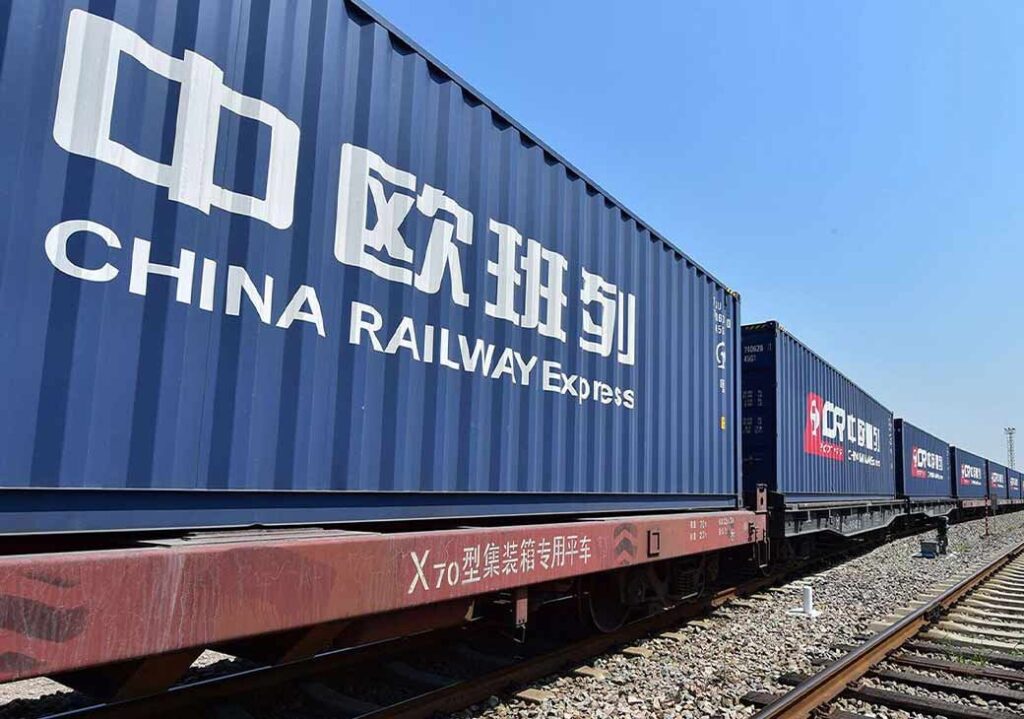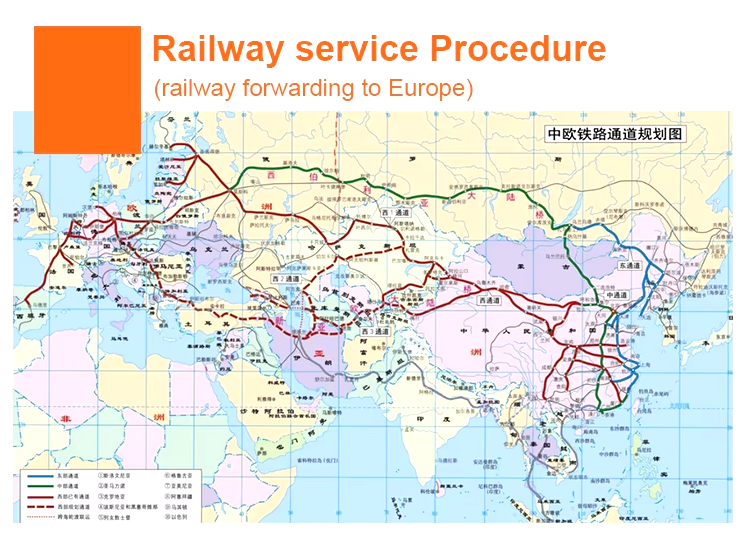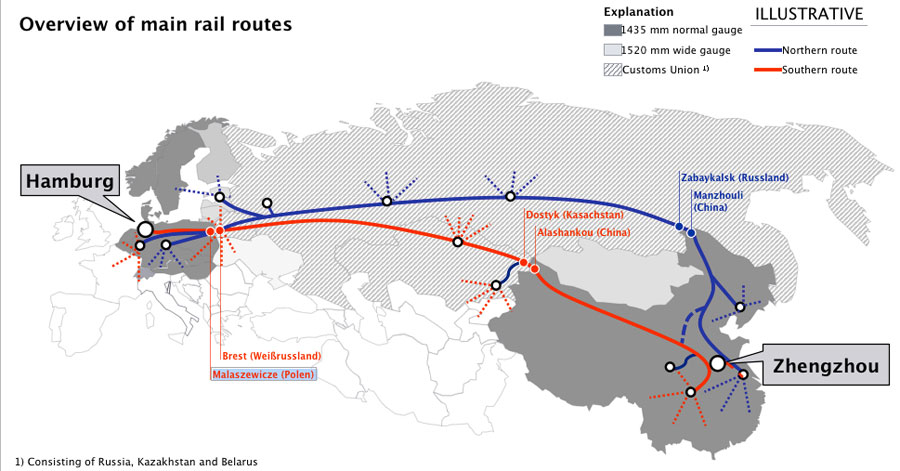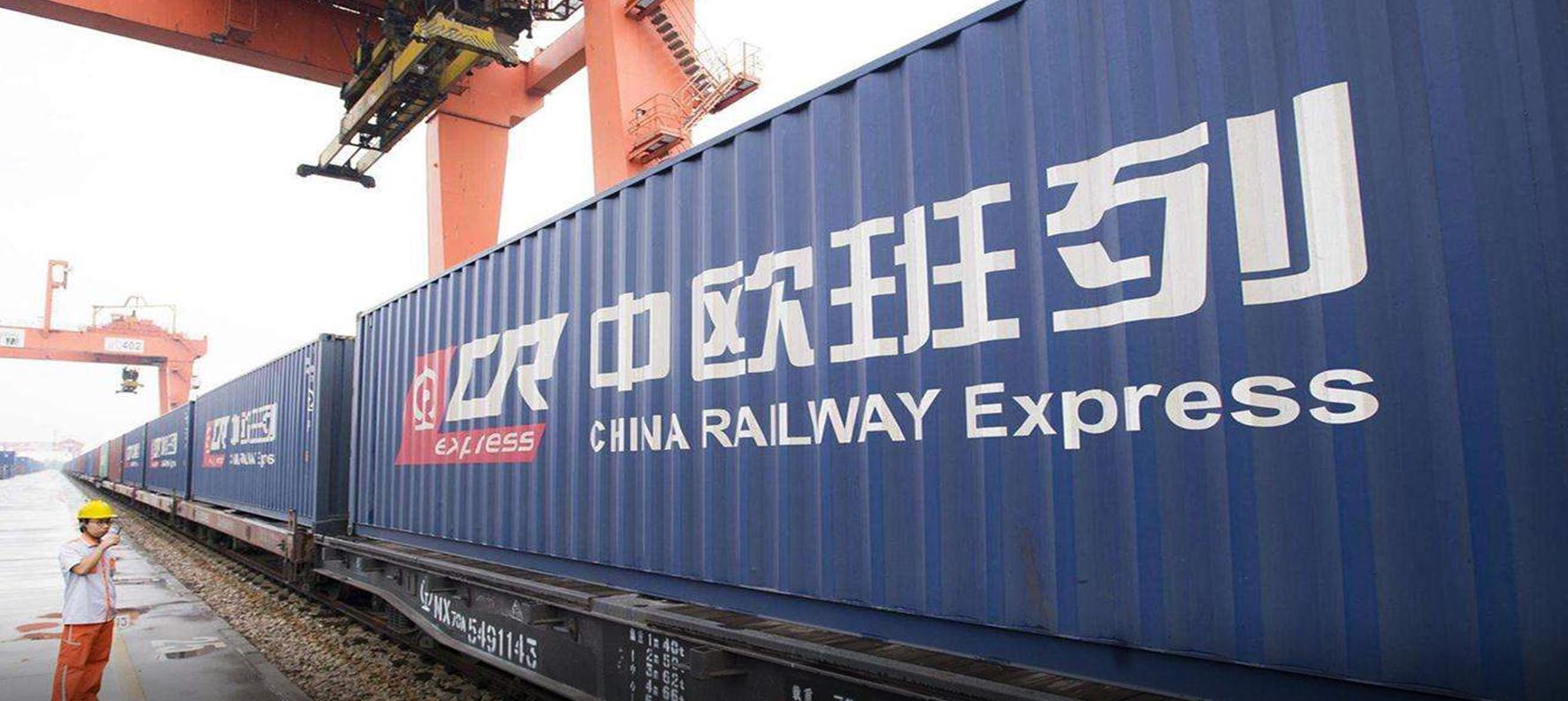
- Transportation Arrangements
- Customs Clearance
- Tax and Duty Payment
- Risk Management
- Cargo Insurance
- Documentation Handling
- Final Delivery
As businesses increasingly seek efficient and cost-effective logistics solutions, the Rail Freight Service from China to Europe has emerged as a vital option for international trade. This service not only minimizes transit times—typically ranging from 12 to 20 days—but also strikes a balance between affordability and reliability compared to air and sea freight. With major routes connecting key cities in China and Europe, rail freight is transforming how goods are transported across continents.
At Dantful International Logistics, we specialize in providing comprehensive rail freight services tailored to your business needs. Our expertise in managing customs clearance, documentation, and secure transport ensures that your shipments arrive on time and in excellent condition. Whether you’re shipping electronics, textiles, or high-value cargo, our dedicated team is here to guide you through every step of the process.
Don’t let logistical complexities hold your business back. Partner with Dantful International Logistics today to optimize your supply chain with our reliable Rail Freight Service. Contact us now to learn how we can help you streamline your shipping operations and boost your competitive edge in the market.
Introduction to Rail Freight from China to Europe
Overview of the China-Europe Railway Express
The China-Europe Railway Express is a pivotal logistics service that connects China with various European countries, significantly enhancing trade efficiencies. Launched in 2011, this service is part of China’s broader Belt and Road Initiative (BRI), which aims to strengthen economic ties with countries across Asia and Europe. The railway network facilitates the transportation of goods across several routes, making it a reliable alternative to traditional shipping methods such as ocean freight and air freight.

With a typical transit time of 12 to 20 days, the China-Europe Railway Express offers a faster option for shipping goods compared to sea freight, which can take several weeks. The service operates on various routes, including direct lines to major cities like Hamburg, Duisburg, and London, thereby catering to diverse shipping needs. Companies such as Dantful International Logistics provide specialized services to manage the complexities of rail freight, ensuring timely and secure delivery.
Significance in Global Trade and Logistics
Rail freight services from China to Europe play a crucial role in facilitating international trade, especially in light of the growing demand for more efficient and sustainable logistics solutions. The railway network not only reduces transport times but also minimizes the carbon footprint associated with shipping, making it an eco-friendly option for businesses.
Furthermore, the China-Europe Railway Express serves as a bridge connecting significant manufacturing hubs in China with European markets, allowing businesses to optimize their supply chain strategies. As the global economy continues to evolve, rail freight is becoming increasingly relevant, offering competitive pricing and reliability, which are essential for traders looking to import goods from China.
In summary, the significance of rail freight in global trade and logistics cannot be understated. As companies seek to enhance their operational efficiency, services provided by freight forwarders like Dantful International Logistics are instrumental in navigating the complexities of international shipping, including customs clearance and insurance services. The continued expansion of the China-Europe Railway Express is poised to further transform the landscape of global logistics, benefiting traders and businesses across the globe.
Key Benefits of Rail Freight from China to Europe
Cost-Effectiveness Compared to Air and Sea Freight
When evaluating shipping methods, cost is a significant factor for businesses considering their logistics options. Rail freight from China to Europe offers a compelling balance between price and speed, making it more cost-effective than air freight, while outperforming sea freight in terms of transit times.
Typically, shipping a container via air can cost up to five times more than rail transport, which is not feasible for businesses looking to maximize profit margins. On the other hand, while sea freight remains less expensive, the longer transit times can lead to increased inventory holding costs and potential stock shortages. By choosing rail freight services through providers like Dantful International Logistics, businesses can enjoy competitive rates without compromising on efficiency, allowing them to maintain smoother operations.
Speed and Efficiency: Transit Times Explained
One of the most compelling advantages of rail freight is its speed. The transit time for rail transport between China and Europe typically ranges from 12 to 20 days, which is significantly faster than sea freight, which can take 30 days or longer depending on routes and port congestion. In contrast, air freight, while quicker, is much more expensive and primarily suitable for high-value, time-sensitive shipments.
The efficiency of rail transport not only helps businesses reduce lead times but also supports just-in-time inventory practices, enabling companies to receive products faster and respond more swiftly to market demands. Freight forwarders like Dantful International Logistics enhance this efficiency by offering comprehensive services such as customs clearance, ensuring that goods pass through borders with minimal delays.
Environmental Advantages of Rail Transport
In an era where sustainability is becoming increasingly important, rail freight presents a more environmentally friendly option compared to other modes of transportation. Trains are known for their lower carbon emissions per ton-kilometer compared to trucks and ships. According to the International Energy Agency (IEA), rail transport emits up to 75% less CO2 compared to road transport.
By promoting sustainable practices, businesses that utilize rail freight not only contribute to reducing their carbon footprint but also align themselves with customer preferences for environmentally responsible logistics. Furthermore, with growing regulations around emissions, incorporating rail freight services offered by companies such as Dantful International Logistics can help businesses stay compliant while improving their overall sustainability profile.
Major Routes of the China-Europe Rail Network
The Eurasian Land Bridge: Connecting Continents
The Eurasian Land Bridge, also known as the New Silk Road, is a critical component of the China-Europe rail network, providing a vital link between Asia and Europe. This extensive railway system facilitates the movement of goods across multiple countries, connecting significant economic zones and markets. The bridge not only enhances trade efficiency but also fosters cultural and economic exchanges between nations.
The Eurasian Land Bridge plays a critical role in global logistics, enabling companies to transport products swiftly and efficiently. As part of the Belt and Road Initiative (BRI), this network has seen substantial investments in infrastructure and logistics capabilities, making it an attractive option for businesses looking to expand their operations. Freight forwarders like Dantful International Logistics leverage this network to streamline the shipping process from China to Europe, ensuring timely deliveries while adhering to international standards.

Key Departure Cities in China
Several key cities in China serve as major departure points for rail freight shipments destined for Europe. Among these are:
- Chengdu: Known for its strategic location, Chengdu is a central hub for various rail routes and provides direct access to numerous European destinations.
- Xi’an: This ancient city acts as a pivotal link in the rail network, connecting Asia to Europe and facilitating trade through its well-established logistics infrastructure.
- Wuhan: With its extensive rail connections, Wuhan has emerged as another critical departure point for shipments heading to Europe, offering businesses diverse routing options.
These cities are equipped with modern logistics facilities and infrastructure, allowing freight forwarders like Dantful International Logistics to efficiently manage shipments and optimize transit times, ensuring a seamless shipping experience.
Major European Destinations
The China-Europe rail network connects to numerous major cities across Europe, making it an indispensable component of international trade. Some of the primary European destinations include:
- Hamburg, Germany: A leading port city and logistical hub, Hamburg is a significant destination for goods arriving from China, facilitating further distribution throughout Europe.
- Duisburg, Germany: This city is renowned for its inland port and serves as a critical logistics center for goods entering Europe, making it one of the most popular destinations for rail freight.
- London, United Kingdom: As a major financial center, London attracts a variety of goods from China, thanks to its robust trade connections facilitated by the rail network.
- Lodz, Poland: Known as the “Polish Manchester,” Lodz is an emerging logistics hub that supports trade and distribution within Central and Eastern Europe.
These destinations highlight the extensive reach of the China-Europe rail network, underscoring its importance for businesses looking to import goods from China. By partnering with freight forwarders like Dantful International Logistics, businesses can benefit from efficient rail freight services that navigate complex international logistics, ensuring timely and cost-effective delivery to various European markets.
In summary, the major routes of the China-Europe rail network, including the Eurasian Land Bridge, key departure cities in China, and major European destinations, all contribute to the growing significance of rail freight in global trade. Companies leveraging this network can enhance their operational efficiency, expand market access, and capitalize on the advantages of rail transport in today’s competitive landscape.
Transit Times and Shipping Rates
Average Transit Times for Various Routes
Understanding the transit times associated with different shipping routes is crucial for businesses looking to optimize their logistics strategies. The China-Europe Railway Express offers competitive transit times that vary depending on the specific route chosen. On average, the transit times for rail freight from key cities in China to major European destinations are as follows:
| Route | Average Transit Time |
|---|---|
| Chengdu to Duisburg | 12-14 days |
| Xi’an to Hamburg | 14-16 days |
| Wuhan to London | 15-18 days |
| Yiwu to Madrid | 16-20 days |
| Nanchang to Warsaw | 14-16 days |
These transit times are significantly shorter than sea freight, which can take anywhere from 30 to 45 days, depending on port congestion and other factors. Additionally, while air freight offers the fastest transit times, it comes with a higher price tag. Providers like Dantful International Logistics ensure that businesses are well-informed about these transit times, allowing for better planning and inventory management.
Comparison of Costs: Rail vs. Air vs. Sea Freight
Cost comparison among different shipping methods is essential for businesses aiming to maximize their logistics budget. Below is an overview of the typical cost implications for rail, air, and sea freight:
| Shipping Method | Average Cost per Container (20ft) | Typical Transit Time |
|---|---|---|
| Rail Freight | $3,000 – $5,000 | 12-20 days |
| Air Freight | $12,000 – $30,000 | 3-7 days |
| Sea Freight | $1,000 – $2,500 | 30-45 days |
From this comparison, it is evident that while sea freight generally offers the lowest cost per container, the significantly longer transit time may lead to increased inventory holding costs, which can impact overall profitability. Conversely, air freight is the fastest option but comes with extremely high costs, making it suitable primarily for urgent, high-value shipments.
Rail freight stands out as a middle-ground solution, offering a balance of speed and cost that appeals to many companies. With an average cost of $3,000 to $5,000 for a 20ft container and a transit time of 12 to 20 days, it serves as an attractive option for businesses looking to import goods from China without incurring the steep costs associated with air freight.
By utilizing the services of freight forwarders like Dantful International Logistics, businesses can access customized solutions that consider their specific shipping needs while optimizing costs and transit times. The ability to understand and compare these factors allows companies to make informed decisions and streamline their logistics operations effectively.
In conclusion, examining transit times and shipping rates is essential for businesses involved in international trade. By choosing the right shipping method—whether it be rail, air, or sea—companies can enhance their operational efficiency, reduce costs, and improve overall customer satisfaction in their supply chain processes.
Types of Cargo Transported via Rail
Common Goods Shipped from China to Europe
The China-Europe Railway Express is utilized for transporting a diverse range of goods, catering to various industries and market demands. Some of the most common types of cargo shipped via rail from China to Europe include:
Electronics: Consumer electronics, including smartphones, laptops, and other tech gadgets, are among the most frequently transported goods. The relatively short transit times offered by rail freight make it an ideal choice for meeting the rapid demand in European markets.
Textiles and Apparel: Clothing, fabrics, and textile products are shipped in significant quantities, as the fashion industry requires timely deliveries to keep up with seasonal trends.
Automotive Parts: Rail freight is increasingly being used to transport components and parts for the automotive industry, ensuring a steady supply chain for manufacturers in Europe.
Machinery and Equipment: Heavy machinery and industrial equipment are often shipped via rail, as the robust rail infrastructure can handle the weight and volume of these items effectively.
Furniture and Home Goods: With European consumers constantly seeking new home furnishings, rail freight is a popular choice for transporting furniture from China.
By utilizing the services of Dantful International Logistics, businesses can ensure efficient handling and delivery of these common goods, with a focus on meeting import regulations and optimizing shipping times.
Special Considerations for High-Value and Time-Sensitive Cargo
When it comes to transporting high-value and time-sensitive cargo, additional considerations come into play. Companies must ensure that their logistics strategy accounts for the unique requirements of such shipments. Some of the special considerations include:
Security Measures: High-value goods, such as electronics or precious materials, require enhanced security during transit. Freight forwarders like Dantful International Logistics implement robust security protocols to safeguard these shipments, including tracking systems and secure handling procedures.
Insurance Coverage: Given the inherent risks associated with high-value cargo, it is essential to secure adequate insurance services. By partnering with experienced logistics providers, businesses can obtain tailored insurance coverage that protects against potential losses during transit.
Temperature Control: For time-sensitive cargo, such as pharmaceuticals or perishable goods, maintaining the appropriate temperature during transportation is crucial. Rail services equipped with refrigerated containers ensure that temperature-sensitive items remain within safe limits throughout the journey.
Expedited Customs Clearance: Time-sensitive shipments must undergo rapid customs clearance to avoid delays. Working with a knowledgeable freight forwarder like Dantful International Logistics can streamline this process, ensuring that all documentation is in order and that goods are released promptly.
In conclusion, understanding the types of cargo transported via rail from China to Europe is essential for businesses aiming to optimize their logistics processes. By leveraging the expertise of freight forwarders like Dantful International Logistics, companies can navigate the complexities of shipping various goods, including high-value and time-sensitive items, while ensuring compliance with regulations and maintaining efficiency in their supply chain.
Customs and Regulatory Considerations
Customs Clearance Processes for Rail Freight
Navigating the customs clearance process is a critical step in ensuring that rail freight shipments from China to Europe are timely and compliant with international regulations. The customs clearance process involves several key steps that help facilitate the smooth transit of goods across borders:
Documentation Preparation: Before the shipment departs, proper documentation must be prepared, including commercial invoices, packing lists, and waybills. Accurate and detailed documentation is essential to avoid delays at customs.
Customs Declaration: Upon arrival in the destination country, a customs declaration must be submitted. This declaration provides authorities with information about the contents of the shipment, its value, and the applicable tariffs. Freight forwarders such as Dantful International Logistics assist businesses in preparing and submitting these declarations to ensure compliance.
Duties and Taxes: Customs authorities will assess the applicable duties and taxes based on the declared value of the goods. It is crucial for businesses to be aware of these costs to avoid unexpected expenses. Utilizing expertise from logistics providers can help businesses calculate these costs accurately.
Inspection and Clearance: Customs may choose to inspect shipments to verify compliance with regulations. Efficient handling of customs inspections is essential to minimize delays. Experienced freight forwarders are well-versed in these processes and can expedite the clearance of shipments.
Release and Delivery: Once customs duties are paid and the shipment is cleared, goods can be released for delivery to their final destination. Freight forwarders manage this process to ensure a seamless transition from customs to the consignee.
Navigating Regulations in Different Countries
As businesses expand their market reach, understanding and navigating the varying regulations in different countries becomes increasingly important. Each country has its own customs regulations, import/export rules, and standards that must be adhered to. Key considerations include:
Import Restrictions: Some products may be subject to import restrictions or bans in specific countries. Companies should be aware of these restrictions to avoid penalties or confiscation of goods. Partnering with a knowledgeable freight forwarder like Dantful International Logistics can help ensure full compliance with local regulations.
Tariff Classification: Accurately classifying goods according to the Harmonized System (HS) codes is crucial for determining the correct duties and taxes. Incorrect classification can lead to delays and additional costs. Freight forwarders can provide valuable support in properly classifying goods to ensure compliance.
Documentation Requirements: Different countries may have varying documentation requirements for customs clearance. Understanding these requirements is essential for a smooth shipping process. Freight forwarders can assist in preparing the necessary documentation to comply with each destination’s regulations.
Trade Agreements: Countries may have trade agreements that impact tariffs and duties on imported goods. Being aware of these agreements can provide cost-saving opportunities for businesses. Logistics providers can help navigate these complexities to maximize the benefits of trade agreements.
In summary, customs and regulatory considerations are fundamental aspects of the rail freight shipping process. By working with experienced freight forwarders like Dantful International Logistics, businesses can successfully navigate customs clearance processes and comply with the various regulations in different countries, ensuring smooth and efficient shipping operations. Understanding these elements is essential for maintaining timely deliveries and optimizing supply chain efficiency in a competitive global marketplace.
Challenges and Solutions in Rail Freight Logistics
Potential Delays and Mitigation Strategies
While the China-Europe Railway Express presents numerous advantages, it is not without its challenges. Potential delays can occur due to various factors that freight forwarders and businesses must proactively address. Some common causes of delays include:
Customs Clearance Issues: Customs inspections and paperwork discrepancies can lead to significant delays. To mitigate this risk, companies should ensure that all documentation is accurate and complete prior to shipment. Partnering with an experienced freight forwarder like Dantful International Logistics can help streamline this process, as they possess deep knowledge of customs regulations and can facilitate smoother clearance.
Weather Conditions: Adverse weather conditions can disrupt railway operations, leading to delays in transit. To address this challenge, businesses should incorporate flexibility into their logistics planning, allowing for potential delays without causing significant disruptions to their supply chain.
Congestion at Key Hubs: Major rail terminals or ports can experience congestion, particularly during peak shipping seasons. To avoid delays associated with congestion, companies can work with freight forwarders to identify alternative routing options or adjust shipping schedules to less busy times.
Technical Failures: Equipment malfunctions or technical failures can hinder rail operations. Companies can mitigate this risk by thoroughly vetting their logistics partners and selecting those with a proven track record of reliability and contingency planning.
By proactively identifying these potential delays and implementing mitigation strategies, businesses can enhance their resilience in rail freight logistics.
Infrastructure Developments Supporting Rail Freight
Infrastructure developments play a critical role in enhancing the efficiency and reliability of rail freight services. Significant investments in railway infrastructure across Asia and Europe have led to improvements that benefit the entire logistics network. Some key developments include:
Upgraded Rail Lines: Many countries have invested in upgrading and expanding rail lines to accommodate heavier and faster trains, which has increased capacity and reduced transit times. This expansion facilitates smoother operations and improves overall service quality.
Intermodal Facilities: Development of intermodal terminals allows for seamless transitions between different modes of transportation, including rail, road, and sea. By providing businesses with integrated logistics solutions, these facilities enhance the overall efficacy of supply chains. Freight forwarders like Dantful International Logistics are positioned to utilize these facilities effectively.
Investment in Digital Technologies: Advancements in technology, such as real-time tracking systems and automated customs clearance processes, contribute to improved transparency and efficiency in rail freight logistics. Businesses can leverage these technologies to monitor shipments and respond rapidly to any issues that may arise.
Enhanced Security Measures: Investments in security infrastructure ensure the safe transit of goods, particularly high-value cargo. Enhanced security measures help mitigate risks and provide peace of mind to businesses transporting valuable products via rail.
In summary, the ongoing infrastructure developments supporting rail freight logistics are crucial for addressing challenges and enhancing operational efficiency. By staying informed about these advancements, businesses can optimize their logistics strategies and benefit from the growing rail network connecting China and Europe.
Conclusion
The rise of rail freight services, particularly through the China-Europe Railway Express, represents a significant shift in global logistics, providing businesses with cost-effective, efficient, and environmentally friendly shipping options. By understanding the nuances of rail freight—from customs and regulatory considerations to the types of cargo transported—companies can make informed decisions that enhance their supply chain performance.
While challenges such as potential delays and infrastructure limitations exist, proactive risk management strategies and ongoing infrastructure improvements pave the way for continued growth and reliability in rail freight logistics. Partnering with experienced freight forwarders like Dantful International Logistics ensures that businesses can navigate this complex landscape with confidence, leveraging our expertise to overcome obstacles and optimize logistics processes.
As the demand for rapid and sustainable shipping solutions continues to evolve, rail freight will play an increasingly vital role in connecting markets and facilitating international trade. By embracing this mode of transportation, businesses can position themselves as competitive players in the global marketplace, driving efficiency and success in their operations.


 Afrikaans
Afrikaans Shqip
Shqip አማርኛ
አማርኛ العربية
العربية Հայերեն
Հայերեն Azərbaycan dili
Azərbaycan dili Euskara
Euskara Беларуская мова
Беларуская мова বাংলা
বাংলা Bosanski
Bosanski Български
Български Català
Català Cebuano
Cebuano Chichewa
Chichewa 简体中文
简体中文 繁體中文
繁體中文 Corsu
Corsu Hrvatski
Hrvatski Čeština
Čeština Dansk
Dansk Nederlands
Nederlands English
English Esperanto
Esperanto Eesti
Eesti Filipino
Filipino Suomi
Suomi Français
Français Galego
Galego ქართული
ქართული Deutsch
Deutsch Ελληνικά
Ελληνικά Kreyol ayisyen
Kreyol ayisyen Harshen Hausa
Harshen Hausa Ōlelo Hawaiʻi
Ōlelo Hawaiʻi עִבְרִית
עִבְרִית हिन्दी
हिन्दी Hmong
Hmong Magyar
Magyar Íslenska
Íslenska Igbo
Igbo Bahasa Indonesia
Bahasa Indonesia Gaeilge
Gaeilge Italiano
Italiano 日本語
日本語 Basa Jawa
Basa Jawa ಕನ್ನಡ
ಕನ್ನಡ Қазақ тілі
Қазақ тілі ភាសាខ្មែរ
ភាសាខ្មែរ 한국어
한국어 كوردی
كوردی Кыргызча
Кыргызча ພາສາລາວ
ພາສາລາວ Latin
Latin Latviešu valoda
Latviešu valoda Lietuvių kalba
Lietuvių kalba Lëtzebuergesch
Lëtzebuergesch Македонски јазик
Македонски јазик Malagasy
Malagasy Bahasa Melayu
Bahasa Melayu മലയാളം
മലയാളം Maltese
Maltese Te Reo Māori
Te Reo Māori मराठी
मराठी Монгол
Монгол ဗမာစာ
ဗမာစာ नेपाली
नेपाली Norsk bokmål
Norsk bokmål پښتو
پښتو فارسی
فارسی Polski
Polski Português
Português ਪੰਜਾਬੀ
ਪੰਜਾਬੀ Română
Română Русский
Русский Samoan
Samoan Gàidhlig
Gàidhlig Српски језик
Српски језик Sesotho
Sesotho Shona
Shona سنڌي
سنڌي සිංහල
සිංහල Slovenčina
Slovenčina Slovenščina
Slovenščina Afsoomaali
Afsoomaali Español
Español Basa Sunda
Basa Sunda Kiswahili
Kiswahili Svenska
Svenska Тоҷикӣ
Тоҷикӣ தமிழ்
தமிழ் తెలుగు
తెలుగు ไทย
ไทย Türkçe
Türkçe Українська
Українська اردو
اردو O‘zbekcha
O‘zbekcha Tiếng Việt
Tiếng Việt Cymraeg
Cymraeg יידיש
יידיש Yorùbá
Yorùbá Zulu
Zulu